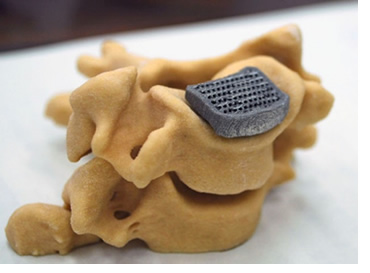Japanese Researchers 3D Print Spine Implants
 Researchers from the Kyoto University Graduate School of Medicine announced they have implanted 3D printed titanium bone replacements into the spines of four patients. The patients were previously diagnosed with herniated cervical disks. They reported that after the operations walking and other movements became easier for them. The implants also helped ease the numbness some of them were experiencing in their limbs.
Researchers from the Kyoto University Graduate School of Medicine announced they have implanted 3D printed titanium bone replacements into the spines of four patients. The patients were previously diagnosed with herniated cervical disks. They reported that after the operations walking and other movements became easier for them. The implants also helped ease the numbness some of them were experiencing in their limbs.
The researchers at Kyoto used a multi-step process to create the customized bone replacements. They began by taking a CT scan of the patient`s spine and used it to create a 3D printable model of what the damaged areas should look like if they were healthy. Then they used an Electron Beam Melting (EBM) 3D printer to create the implants out of titanium. After printing, the titanium bone replacement pieces underwent heat and chemical treatments before finally being implanted into the patients.
According to the Kyoto team, these types of 3D printed implants are superior to other bone replacement solutions currently in use. Right now, the most common method of fixing damaged bones is to pull matter from other areas of the body or use a replacement piece from a cadaver. Alternately, ceramics or metal alloys can be used to create inserts but there is an increased risk of rejection involved in the procedure. The specially printed titanium inserts on the other hand, are strong enough to provide the needed spinal support and are porous enough that the bones on either side of the implant can grow into them over time.
The team from Kyoto University also reported they have printed out a titanium femur and skull implant, though they did not say whether they have surgically implanted those pieces into patients yet.
Other universities around the world are working on projects similar to those at Kyoto. At the Peking University Third Hospital in Beijing they are conducting clinical trials with 3D printed titanium spinal implants and at Cornell University they are adding stem cells into the mix.


Leave a Reply
Want to join the discussion?Feel free to contribute!